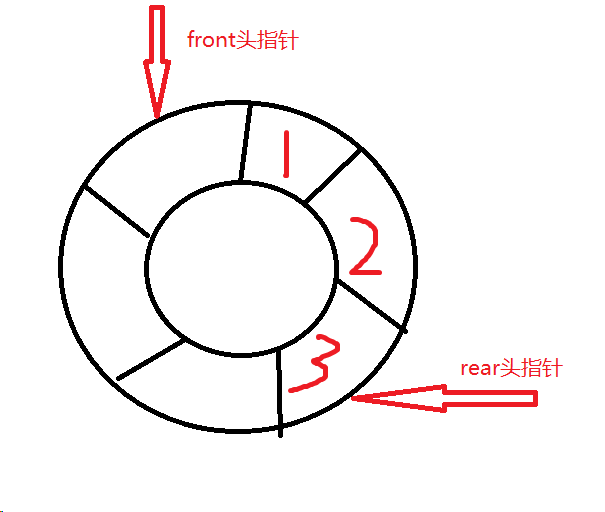今日在處理數據存儲的問題中,數據占用的空間較大,在詢問之下,提及迴圈隊列。 沒有學習過的我,想想就是頭大,只能慢慢從網上找資料,一個字母一個字母的敲,最後,還是慢慢的對隊列有了一些理解 對於迴圈隊列有幾個操作: 1、初始化 2、入隊 3、出隊 4、遍歷隊列 5、判隊列空,判隊列滿 具體如何實現,我會 ...
今日在處理數據存儲的問題中,數據占用的空間較大,在詢問之下,提及迴圈隊列。
沒有學習過的我,想想就是頭大,只能慢慢從網上找資料,一個字母一個字母的敲,最後,還是慢慢的對隊列有了一些理解
對於迴圈隊列有幾個操作:
1、初始化
2、入隊
3、出隊
4、遍歷隊列
5、判隊列空,判隊列滿
具體如何實現,我會在下麵通過代碼實現
在對迴圈隊列操作之前,先要建立隊列結構體元素,
1 typedef struct Queue 2 { 3 int * BUF; 4 int front; 5 int rear; 6 }QUEUE;
1、初始化
初始化,需要完成的工作是,為新建的隊列分配記憶體空間,然後在將頭尾指針置零
1 void initQueue(QUEUE *queue_q) 2 { 3 queue_q->BUF = (int *)malloc(sizeof(int)*BUF_SIZE); 4 if(queue_q->BUF != NULL) //隊列記憶體分配成功 5 { 6 queue_q->front = queue_q->rear = 0; //初始化頭尾指針 7 } 8 9 }
2、入隊
入隊主要是將數據放到記憶體中,但是應該放到那一段記憶體,這就是一個問題了,
在此,在入隊的時候,迴圈隊列的頭指針不做動作,尾指針向後偏移
實現代碼如下:
其中的 BUF_SIZE 為迴圈隊列的空間大小嗎,但是實際能存儲的數據位元組數是(BUF_SIZE - 1)
#define BUF_SIZE 8
1 void In_Queue(QUEUE *queue_q , int value) 2 { 3 if(is_fullQueue(queue_q) != true) //隊列未滿 4 { 5 queue_q->BUF[queue_q->rear] = value; 6 queue_q->rear = (queue_q->rear + 1)%BUF_SIZE ; //尾指針偏移 7 } 8 }
細心的人會註意到函數 is_fullQueue(queue_q) ,這是對迴圈隊列進行判斷,看是不是滿了,應該隊列的空間是有限的,對於滿的隊列,無法進行數據入隊操作
具體函數如下:
1 unsigned char is_fullQueue(QUEUE *queue_q) 2 { 3 if((queue_q->rear +1)%BUF_SIZE == queue_q->front) 4 { 5 return true; 6 }else 7 return false; 8 }
同樣,存在一個判空函數,函數的原理是:頭指針 = 尾指針
實現代碼如下:
1 unsigned char isemptyQueue(QUEUE *queue_q) 2 { 3 if(queue_q->front == queue_q->rear) 4 { 5 return true; 6 } 7 else 8 return false; 9 }
3、出隊
出隊是將頭指針位置下的數據取出來,然後頭指針偏移到被取數據的位置
代碼實現如下:
1 void out_Queue(QUEUE *queue_q , int *value) 2 { 3 if(isemptyQueue(queue_q) != true) //隊列未空 4 { 5 *value = queue_q->BUF[queue_q->front]; 6 queue_q->front = (queue_q->front + 1)%BUF_SIZE ; 7 } 8 }
入隊要判滿,出隊則要判空。
因為空的隊列,沒辦法取數據
4、遍歷隊列
這就是一個簡單的列印函數,沒什麼好說的
唯一需要註意的就是,遍歷是出隊操作,操作的是頭指針,若頭指針 = 尾指針,遍歷完畢,迴圈隊列為空
1 void bianli_a(QUEUE *queue_q) 2 { 3 if(isemptyQueue(queue_q) != true) 4 { 5 int ret=queue_q->front; 6 while(ret != queue_q->rear) 7 { 8 printf("%d ",queue_q->BUF[ret]); 9 ret=(ret+1)%BUF_SIZE; 10 } 11 } 12 }
下麵是我學習迴圈隊列的時候,寫的代碼,若有指教,請評論:
1 #include <stdio.h> 2 #include <malloc.h> 3 #include <stdlib.h> 4 5 #define true 1 6 #define false 0 7 #define BUF_SIZE 8 8 typedef struct Queue 9 { 10 int * BUF; 11 int front; 12 int rear; 13 }QUEUE; 14 15 void initQueue(QUEUE *queue_q) 16 { 17 queue_q->BUF = (int *)malloc(sizeof(int)*BUF_SIZE); 18 if(queue_q->BUF != NULL) //隊列記憶體分配成功 19 { 20 queue_q->front = queue_q->rear = 0; //初始化頭尾指針 21 } 22 23 } 24 25 //判空 26 unsigned char isemptyQueue(QUEUE *queue_q) 27 { 28 if(queue_q->front == queue_q->rear) 29 { 30 return true; 31 } 32 else 33 return false; 34 } 35 36 //判滿 37 unsigned char is_fullQueue(QUEUE *queue_q) 38 { 39 if((queue_q->rear +1)%BUF_SIZE == queue_q->front) 40 { 41 return true; 42 }else 43 return false; 44 } 45 46 //入隊 47 48 void In_Queue(QUEUE *queue_q , int value) 49 { 50 if(is_fullQueue(queue_q) != true) //隊列未滿 51 { 52 queue_q->BUF[queue_q->rear] = value; 53 queue_q->rear = (queue_q->rear + 1)%BUF_SIZE ; //尾指針偏移 54 } 55 } 56 57 58 //出隊 59 void out_Queue(QUEUE *queue_q , int *value) 60 { 61 if(isemptyQueue(queue_q) != true) //隊列未空 62 { 63 *value = queue_q->BUF[queue_q->front]; 64 queue_q->front = (queue_q->front + 1)%BUF_SIZE ; 65 } 66 } 67 68 void bianli_a(QUEUE *queue_q) 69 { 70 if(isemptyQueue(queue_q) != true) 71 { 72 int ret=queue_q->front; 73 while(ret != queue_q->rear) 74 { 75 printf("%d ",queue_q->BUF[ret]); 76 ret=(ret+1)%BUF_SIZE; 77 } 78 } 79 } 80 81 int main() 82 { 83 int val; 84 QUEUE m; 85 initQueue(&m); 86 In_Queue(&m,1); 87 In_Queue(&m,2); 88 In_Queue(&m,3); 89 bianli_a(&m); 90 printf("\n"); 91 out_Queue(&m,&val); 92 bianli_a(&m); 93 return 0; 94 }



